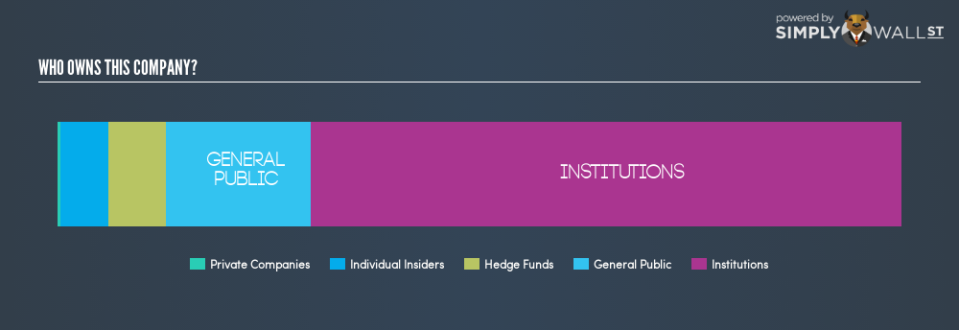Who Are The Top Investors In Braemar Hotels & Resorts Inc (NYSE:BHR)?

In this article, I’m going to take a look at Braemar Hotels & Resorts Inc’s (NYSE:BHR) latest ownership structure, a non-fundamental factor which is important, but remains a less discussed subject among investors. The impact of a company’s ownership structure affects both its short- and long-term performance. The same amount of capital coming from an activist institution and a passive mutual fund has different implications on corporate governance, which is a decisive factor for a long-term investor. It also impacts the trading environment of company shares, which is more of a concern for short-term investors. Now I will analyze BHR’s shareholder registry in more detail.
See our latest analysis for Braemar Hotels & Resorts
Institutional Ownership
Institutions account for 60.3% of BHR’s outstanding shares, a significant enough holding to move stock prices if they start buying and selling in large quantities, especially when there are relatively small amounts of shares available on the market to trade. Although BHR has a high institutional ownership, such stock moves, in the short-term, are more commonly linked to a particular type of active institutional investors – hedge funds. Hedge funds, considered active investors, hold a 5.9% stake in the company, which may be the cause of high short-term volatility in the stock price. But I also examine other ownership types and their potential impact on BHR’s investment case.
Insider Ownership
Insiders form a group of important ownership types as they manage the company’s operations and decide the best use of capital. Insider ownership has been linked to better alignment between management and shareholders. Although individuals in BHR hold only a 5.0% stake, it’s a good sign for shareholders as the company’s executives and directors have their incentives directly linked to the company’s performance. I will also like to check what insiders have been doing recently with their holdings. Insider buying may be a sign of upbeat future expectations, however, selling doesn’t necessarily mean the opposite as insiders may be motivated by their personal financial needs.
General Public Ownership
A big stake of 14.8% in BHR is held by the general public. With this size of ownership, retail investors can collectively play a role in major company policies that affect shareholders returns, including executive remuneration and the appointment of directors. They can also exercise the power to decline an acquisition or merger that may not improve profitability.
Private Company Ownership
Another group of owners that a potential investor in BHR should consider are private companies, with a stake of 0.3%. While they invest more often due to strategic interests, an investment can also be driven by capital gains through share price appreciation. However, an ownership of this size may be relatively insignificant, meaning that these shareholders may not have the potential to influence BHR’s business strategy. Thus, investors not need worry too much about the consequences of these holdings.
Next Steps:
I suggest investors seek some degree of margin of safety due to high institutional ownership in BHR, in particular due to the strong presence of active hedge fund investors. This will allow an investor to reduce the impact of non-fundamental factors, such as volatile block trading impact on their portfolio value. However, ownership structure should not be the only focus of your research when constructing an investment thesis around BHR. Rather, you should be looking at fundamental drivers such as the intrinsic valuation, which is a key driver of Braemar Hotels & Resorts’s share price. I urge you to complete your research by taking a look at the following:
Future Outlook: What are well-informed industry analysts predicting for BHR’s future growth? Take a look at our free research report of analyst consensus for BHR’s outlook.
Past Track Record: Has BHR been consistently performing well irrespective of the ups and downs in the market? Go into more detail in the past performance analysis and take a look at the free visual representations of BHR’s historicals for more clarity.
Other High-Performing Stocks: Are there other stocks that provide better prospects with proven track records? Explore our free list of these great stocks here.
NB: Figures in this article are calculated using data from the last twelve months, which refer to the 12-month period ending on the last date of the month the financial statement is dated. This may not be consistent with full year annual report figures.
To help readers see past the short term volatility of the financial market, we aim to bring you a long-term focused research analysis purely driven by fundamental data. Note that our analysis does not factor in the latest price-sensitive company announcements.
The author is an independent contributor and at the time of publication had no position in the stocks mentioned. For errors that warrant correction please contact the editor at editorial-team@simplywallst.com.

 Yahoo Finance
Yahoo Finance 
